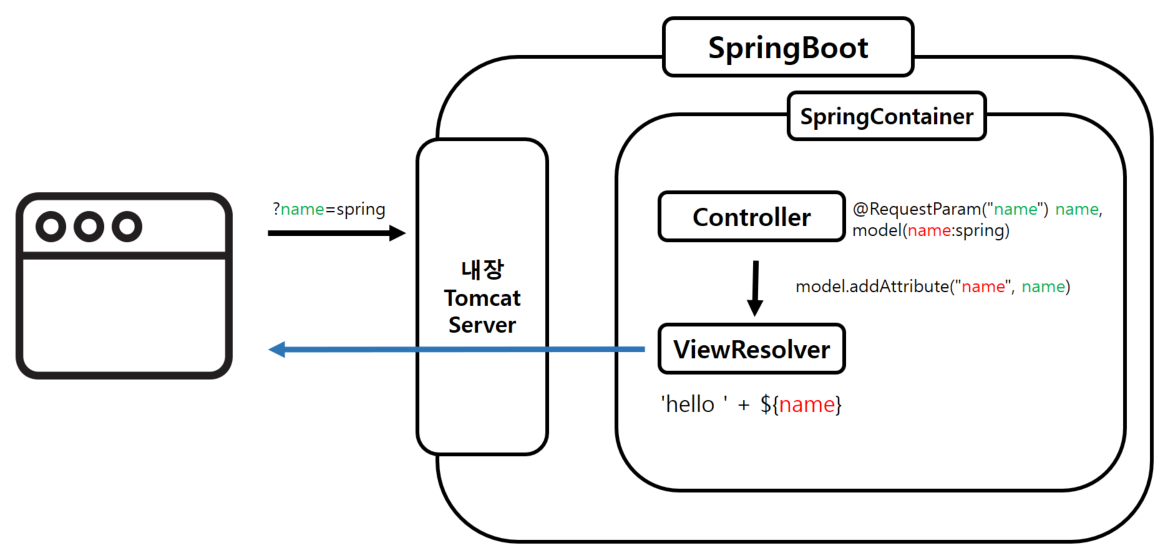김영한 님의 스프링 입문 - 코드로 배우는 스프링 부트, 웹 MVC, DB 접근 기술 강의를 보고 작성한 내용입니다.
https://www.inflearn.com/course/%EC%8A%A4%ED%94%84%EB%A7%81-%EC%9E%85%EB%AC%B8-%EC%8A%A4%ED%94%84%EB%A7%81%EB%B6%80%ED%8A%B8/dashboard
5. 정적 컨텐츠
-
정척 컨텐츠 : 파일을 그대로 클라이언트(웹 브라우저)에게 전달
-
SringBoot는 정적 컨텐츠를
static에서 찾아서 제공 -
접속방법 :
localhost:8080/파일명.html
6. MVC와 템플릿엔진
6-1. 템플릿엔진
-
JSP, PHP와 같은 것들이 템플릿엔진
-
템플릿엔진 : HTML을 그냥 주는 것이 아니라 서버에서 프로그래밍해서(HTML을 변형해서) 동적으로 준다
-
이를 위해 Controller, Model, View가 필요
6-2. MVC
-
View : 화면을 그리는데 집중
-
Controller : 비지니스 로직이나 서버 내부적인 것을 처리하는데 집중
-
Model : View에 필요한 데이터를 담는다
6-3. 동작 흐름
< HelloController >
@GetMapping("hello-mvc")
public String helloMVC(@RequestParam("name") String name, Model model) {
model.addAttribute("name", name);
return "hello-template";
}-
@RequestParam: 외부에서 파라미터를 받음 -
@RequestParam("name") String name: 외부의 name을 String name으로 받음 -
return 하는 것은 html의 이름
- 해당 html에서 model을 사용 가능
< hello-template.html >
<p th:text="'hello ' + ${name}">hello! empty</p>- name에 값을 받으면 hello! empty가 태그 안의 내용으로 치환됨
6-4. 참고
-
http://localhost:8080/hello-mvc로 접속하면 에러 발생-
에러 : Required request parameter 'name' for method parameter type String is not present
-
@RequestParam에 name이 지정되어 있는데 아무것도 전달되지 않았기 때문
-
해결 :
http://localhost:8080/hello-mvc?name=spring처럼 입력한다
-
-
@RequestParam의 속성인required의 default 값은 true- true이면 무조건 파라미터가 전달되어야 함을 의미
7. API
7-1. 설명
-
서버에서 클라이언트에게 JSON 형식으로 데이터를 전달
-
MVC는 HTML에 데이터를 담아서 내리지만 API는 데이터를 바로 내린다
7-2. 동작 흐름
-
@ResponseBody가 없으면 viewResolver가 동작 -
@ResponseBody를 사용하면-
HTTP의 Body에 직접 데이터를 넣어준다는 의미 ( HTTP에는 Header, Body가 존재 )
-
viewResolver 대신에
HttpMessageConverter가 동작- 템플릿엔진처럼 model에 담아서 HTML로 내리는 것이 아니라 데이터를 직접 내려보낸다
-
클라이언트의 HTTP Accept 헤더와 서버의 컨트롤러 retun 타입 정보를 조합해서
HttpMessageConverter가 선택된다 -
기본 문자처리:
StringHttpMessageConverter -
기본 객체처리:
MappingJackson2HttpMessageConverter -
byte 처리 등등 기타 여러
HttpMessageConverter가 기본으로 등록되어 있음
-
7-3. 코드
< Controller >
@GetMapping("hello-string")
@ResponseBody
public String helloString(@RequestParam("name") String name) {
return "hello " + name;
}@ResponseBody를 사용하면 뷰 리졸버( viewResolver )를 사용하지 않음- 대신에 HTTP의 BODY에 문자 내용을 직접 반환
static class Hello {
private String name;
public String getName() {
return name;
}
public void setName(String name) {
this.name = name;
}
}
@GetMapping("hello-api")
@ResponseBody
public Hello helloApi(@RequestParam("name") String name) {
Hello hello = new Hello();
hello.setName(name);
return hello;
}@ResponseBody를 사용하면서 객체가 반환되면 객체가 JSON으로 변환됨


